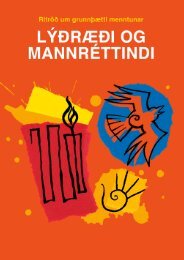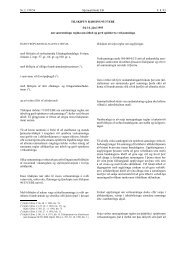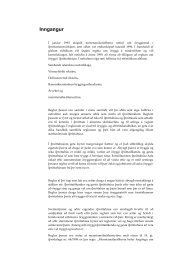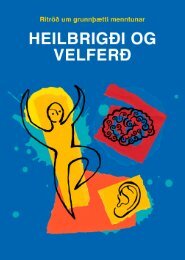Arts and Cultural Education in Iceland : Professor Anne Bamford
Arts and Cultural Education in Iceland : Professor Anne Bamford
Arts and Cultural Education in Iceland : Professor Anne Bamford
You also want an ePaper? Increase the reach of your titles
YUMPU automatically turns print PDFs into web optimized ePapers that Google loves.
Chapter 2 World Benchmark<strong>in</strong>g<br />
2.1 Introduction<br />
For the positive impacts of arts education to become apparent, children must experience<br />
high quality arts education. The results from the global study of arts education suggest that <strong>in</strong><br />
around ¼ of all <strong>in</strong>stance of arts education, the quality is so low as to negatively effect a child’s<br />
artistic <strong>and</strong> creative development 16 . Given this, it is imperative that the arts education with<strong>in</strong><br />
Icel<strong>and</strong> reaches certa<strong>in</strong> levels of quality. This chapter outl<strong>in</strong>es the basic components that<br />
together form high quality arts education.<br />
2.2 World st<strong>and</strong>ards: Def<strong>in</strong><strong>in</strong>g the alpha of quality arts education<br />
Art education – like health – is not a mono-causal phenomenon but one which h<strong>in</strong>ges on<br />
many variables po<strong>in</strong>t<strong>in</strong>g <strong>in</strong> the same direction. Statisticians have developed a measure of this.<br />
The so-called Cronbach’s Alpha (Bogt, 1993) measures the consistency between factors <strong>in</strong> a<br />
compound phenomena. The higher consistency there is between the qualities, the higher the<br />
Cronbach Score. Statistically speak<strong>in</strong>g, total consistency equals 1, whereas no consistency at all<br />
equals 0 (Bogt, 1993).<br />
This is certa<strong>in</strong>ly not to suggest that a Cronbach score can be derived for the arts by criteria,<br />
averages, <strong>and</strong> global means. <strong>Education</strong>al systems are deeply embedded <strong>in</strong> cultural <strong>and</strong> nation<br />
specific contexts. This is especially the case as regards education <strong>in</strong> the arts. More than any<br />
other subject, the arts (itself a broad category) reflect unique cultural circumstances, <strong>and</strong><br />
consequently, so does the teach<strong>in</strong>g of the subject.<br />
So any Alpha developed must respect <strong>and</strong> encourage this diversity. Judd (Judd et al., 1993)<br />
refers to this more as a gossamer concept, where a set of abstract constructs are grouped<br />
together consistently to create a somewhat dependable phenomena. Just as ‘health’ may be a<br />
collection of measurable factors (e.g. steady pulse, low cholesterol <strong>and</strong> good metabolism etc),<br />
well-be<strong>in</strong>g comprises of a number of constructs such as happ<strong>in</strong>ess, contentment, power, social<br />
roles <strong>and</strong> so on.<br />
Related to arts education, we know that quality programmes have a number of measurable<br />
characteristics <strong>in</strong> common, such as <strong>in</strong>clusion of partnerships, performances <strong>and</strong> approaches to<br />
learn<strong>in</strong>g but equally they depend on attitudes of risk tak<strong>in</strong>g, collaboration, shar<strong>in</strong>g <strong>and</strong> other<br />
abstract constructs.<br />
These together form the basel<strong>in</strong>e alpha that needs to be considered prior to the<br />
measurement of impact.<br />
It is possible to draw certa<strong>in</strong> overall conclusions <strong>and</strong> to f<strong>in</strong>d common denom<strong>in</strong>ators, which<br />
can serve as a form of alpha for arts education research. Just as social science, researchers have<br />
developed community ‘liveability’ st<strong>and</strong>ards, medical researchers have developed patient wellbe<strong>in</strong>g<br />
<strong>in</strong>dicators <strong>and</strong> the legal system is cont<strong>in</strong>ually called upon to make judgements based on<br />
precedent <strong>and</strong> statutes, the arts community can now – perhaps for the first time – have a<br />
reasonable alpha to use for ascerta<strong>in</strong><strong>in</strong>g quality prior to evaluat<strong>in</strong>g impact.<br />
Throughout the results of the global survey there is an unequivocal <strong>in</strong>dication that certa<strong>in</strong><br />
structures <strong>and</strong> methods of <strong>in</strong>struction are common to all quality programmes regardless of their<br />
16 <strong>Bamford</strong>, A (2006) The Wow Factor: Global research compendium on the impact of arts <strong>in</strong> education. Waxmann, Műnchen.<br />
51


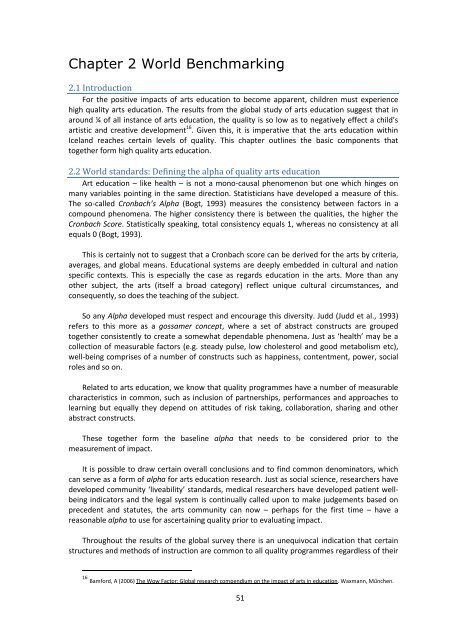
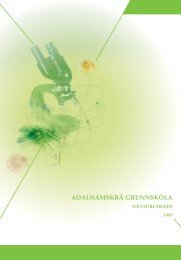
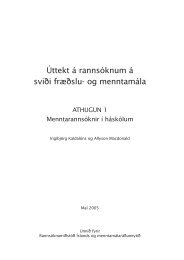

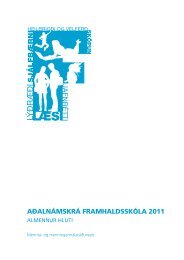
![Aðalnámskrá tónlistarskóla : rytmÃsk tónlist [Eingöngu á rafrænu formi]](https://img.yumpu.com/50843672/1/184x260/aaalnamskra-tanlistarskala-rytma-sk-tanlist-eingangu-a-rafranu-formi.jpg?quality=85)
